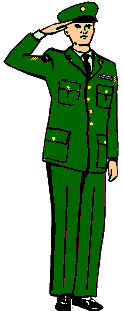
THE SALUTE AND COURTESIES
The Salute
The salute is an act of recognition between military men. Its origin is in the ancient European custom of free men greeting each other by holding up their right hand to show that they had no weapons. The rules of saluting are as follows:
- Salutes are exchanged out of doors, usually at a distance of from six to thirty paces.
- Salute outdoors at the moment of recognition or eye to eye contact is made, or when about six steps away.
- The salute is always initiated first by the subordinate and is terminated only after acknowledgment by the individual being saluted.
- Accompany the salute with an appropriate greeting, such as, "Good morning/afternoon, sir/ma'am."
- Salute all officers (recognized by rank) in official vehicles identified by special plates or flags.
- Salutes are not required to be rendered by or to personnel who are driving or riding in privately owned vehicles.
- When in formation, salute only on command. When leading a formation, salute for the formation.
- If you are on a detail and a senior officer approaches, salute if you are in charge of the detail. Otherwise, continue to work. If you are spoken to, then come to attention.
- If in a group and a senior officer approaches, the first to recognize the officer calls the group to attention and all personnel salute.
- When a senior officer enters a room, the first to recognize the officer calls personnel in the room to attention but does not salute.
- Never render a salute with a noticeable object in your mouth or right hand.
- When the flag is being raised in the morning or lowered in the evening, you should stand at attention on the first note of the national anthem. Give the required salute. If you are involved in some duty that would be hampered by saluting, you do not need to salute. You normally face the flag when saluting, unless duty requires you to face in some other direction. At the conclusion of the ceremony, resume your regular duties.
- Whenever the national anthem or "reveille" is played, and you are not in formation and not in a vehicle, come to attention at the first note, face the flag, and give the required salute. If no flag is near, face the music and salute. If you are in formation, salute only on the order "Present arms." If you are in civilian clothing, stand at attention and place your right hand over your heart. These honors also apply to the national anthems of foreign countries during ceremonies or parades.
- Normally no one salutes indoors. A salute indoors is rendered only when one is reporting. Exceptions are: Reporting to an inspecting officer, reporting to a visiting officer of rank greater than anyone in the room, and reporting when summoned by an officer.
- How to report: "Sir, (your Rank, name) reports."
- When in doubt as to where and when to salute--SALUTE!
GTA 21-2-26 shows the proper position of the salute--learn it.
- The soldier who goes the extra mile by extending his/her courtesy and respect beyond requirements tends to get it back in very satisfactory ways, including, elevation of respect from superiors and personal gratification.
Courtesies
The following rules will help you conduct yourself appropriately in the presence of officers:
- When talking to a senior officer outdoors, stand at attention unless given the order "At ease." When you are dismissed, come to attention and salute.
- When accompanying a senior, walk on their left.
- When entering or exiting a vehicle, the junior ranking person is first to enter, and last to exit the vehicle.
- When a senior officer enters a dining facility, unless directed or a senior officer is present, the diners will be given the order "At ease" by the first person who sees the officer. Remain seated at ease and will continue eating unless the officer directs otherwise. If you are directly addressed, you should rise to attention, if seated in a chair. If you are seated on a bench, stop eating and sit at attention until the conversation is ended. NOTE: The senior officer may give the order "Carry on." This means you should continue with whatever you were doing previously.
- When you report to an officer for any reason, it is important to make a good first impression. If you are outdoors, approach the officer to whom you are reporting and stop approximately two steps from them, assuming the position of attention. Give the proper salute and say, "Sir/Ma'am, (Rank, name) reports." If you are indoors, use the same procedures as above, except remove your headgear before reporting. If you are armed, however, do not remove your headgear.
- While it is not REQUIRED to salute an officer in a POV or when in street clothes, it is a common (that is non-regulation) courtesy in the Army to do so whenever someone is recognized as an officer and the soldier is on duty.
- Secondly, when in a vehicle (official or POV) one should pull to the curb at the safest possible moment, step out and give proper courtesies to retreat, reveille or the national anthem. Again more of a common courtesy than a regulation.
HOME
Contact the webmaster:
Major Dave Gowan
IT Sec HQ SCSG
dgowan@tfn.net

